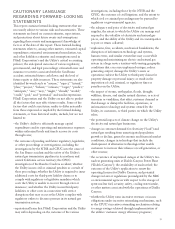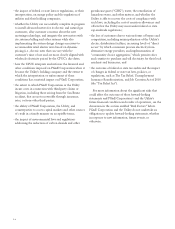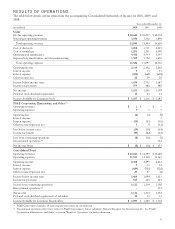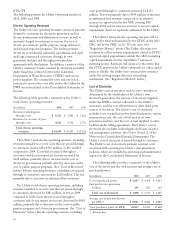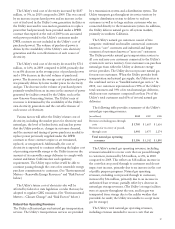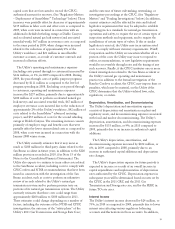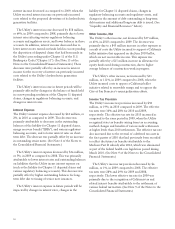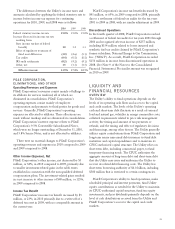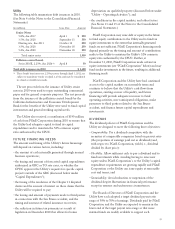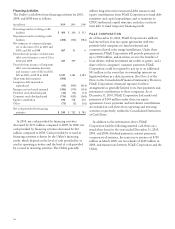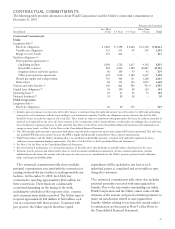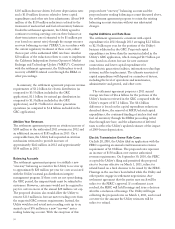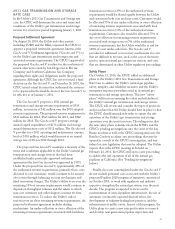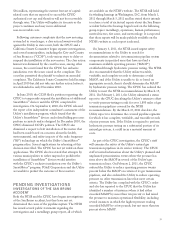PG&E 2010 Annual Report Download - page 27
Download and view the complete annual report
Please find page 27 of the 2010 PG&E annual report below. You can navigate through the pages in the report by either clicking on the pages listed below, or by using the keyword search tool below to find specific information within the annual report.
Utility
The following table summarizes debt issuances in 2010.
(See Note 4 of the Notes to the Consolidated Financial
Statements.)
(in millions) Issue Date Amount
Senior Notes
5.8%, due 2037 April 1 $ 250
3.5%, due 2020 September 15 550
Floating rate, due 2011 October 12 250
3.5%, due 2020 November 18 250
5.4%, due 2040 November 18 250
Total senior notes 1,550
Pollution control bonds
Series 2010E, 2.25%, due 2026 (1) April 8 50
Total debt issuances in 2010 $ 1,600
(1) These bonds bear interest at 2.25% per year through April 1, 2012; are
subject to mandatory tender on April 2, 2012; and may be remarketed
in a fixed or variable rate mode.
The net proceeds from the issuance of Utility senior
notes in 2010 were used to repay outstanding commercial
paper and for general corporate purposes. The net proceeds
from the issuance of the pollution control bonds by the
California Infrastructure and Economic Development
Bank for the benefit of the Utility were used to fund capital
investments and general working capital needs.
The Utility also received a contribution of $190 million
of cash from PG&E Corporation during 2010 to ensure that
the Utility had adequate capital to fund its capital
expenditures and to maintain the 52% common equity
ratio authorized by the CPUC.
FUTURE FINANCING NEEDS
The amount and timing of the Utility’s future financings
will depend on various factors, including:
• the amount of cash internally generated through normal
business operations;
• the timing and amount of forecasted capital expenditures
authorized in GRC or TO rate cases, or whether the
CPUC approves the Utility’s requests for specific capital
projects outside of the GRC (discussed below under
“Capital Expenditures”);
• the timing of the resolution of the Chapter 11 disputed
claims and the amount of interest on these claims that the
Utility will be required to pay;
• the timing and amount of payments made to third parties
in connection with the San Bruno accident, and the
timing and amount of related insurance recoveries;
• the reduction in future tax payments as a result of
legislation in December 2010 that allows for bonus
depreciation on qualified property (discussed below under
“Utility – Operating Activities”); and
• the conditions in the capital markets, and other factors.
(See Notes 13 and 15 of the Notes to the Consolidated
Financial Statements.)
PG&E Corporation may issue debt or equity in the future
to fund equity contributions to the Utility and to fund tax
equity investments to the extent that internally generated
funds are not sufficient. PG&E Corporation’s financing needs
depend primarily on the timing and amount of contributions
made to the Utility to maintain the Utility’s 52% common
equity ratio authorized by the CPUC. Further, at
December 31, 2010, PG&E Corporation made certain tax
equity investments (see “PG&E Corporation” below) and may
fund similar investments in the future, resulting in additional
financing needs.
PG&E Corporation and the Utility have had continued
access to the capital markets on reasonable terms and
continue to believe that the Utility’s cash flows from
operations, existing sources of liquidity, and future
financings will provide adequate resources to fund
operating activities, meet anticipated obligations, make
payments to third parties related to the San Bruno
accident, and finance future capital expenditures and
investments.
DIVIDENDS
The dividend policies of PG&E Corporation and the
Utility are designed to meet the following three objectives:
•Comparability: Pay a dividend competitive with the
securities of comparable companies based on payout ratio
(the proportion of earnings paid out as dividends) and,
with respect to PG&E Corporation, yield (i.e., dividend
divided by share price);
•Flexibility: Allow sufficient cash to pay a dividend and to
fund investments while avoiding having to issue new
equity unless PG&E Corporation’s or the Utility’s capital
expenditure requirements are growing rapidly and PG&E
Corporation or the Utility can issue equity at reasonable
cost and terms; and
•Sustainability: Avoid reduction or suspension of the
dividend despite fluctuations in financial performance
except in extreme and unforeseen circumstances.
The Boards of Directors of PG&E Corporation and the
Utility have each adopted a target dividend payout ratio
range of 50% to 70% of earnings. Dividends paid by PG&E
Corporation and the Utility are expected to remain in the
lower end of the target payout ratio range so that more
internal funds are readily available to support each
23


